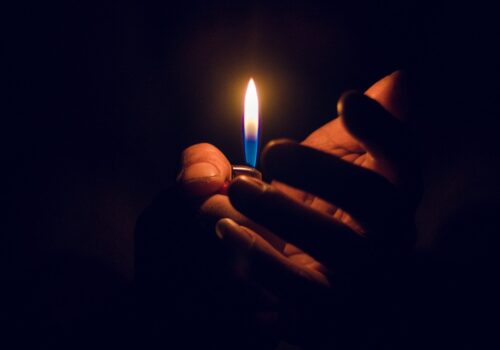Download PDF: Seeman, Ethnography of the Hard Edge
Editors’ Note: This essay is part of the Roundtable on Ethnography and Religion.
Robert Orsi has me thinking about the hard edges of things. What ethnographer has never felt the uncompromising urgency to “get the damned story straight,” especially when mistelling might have real and immediate consequences for people whose very hospitality to a researcher may have compounded their vulnerability? This may be even more complex and morally taxing than Orsi suggests, because sometimes getting the story straight does not mean telling it just the way one’s informants—almost inevitably one’s friends— would like it to be told.
When I wrote One People, One Blood: Ethiopian-Israelis and the Return to Judaism, there came a point at which I realized that I had two somewhat contradictory tasks to which I must remain attentive.1 I needed to resist the state’s devastating insistence on fixed and stable citizen “identities” that frequently influence the categories of social science research. But I also wanted to resist the heroic and sometimes counter-historical narratives offered defensively by many informants. Ethnographers ought to be committed axiomatically never to tell people’s stories in ways that they find obtuse, misinformed, dishonest or unfair, but there is no question that good ethnographic accounts are often destabilizing in other ways. The tale of inconstant nationhood and negotiated religious change I did finally tell was not easy for the some of the people I cared about to hear. To compensate, I found myself adopting strategies of theoretical distancing and academic prose designed, like some medieval religious texts, to frustrate penetration by the uninitiated, and I undertook a studied refusal to provide answers to questions framed in misleading taxonomic and policy terms, even when those might have been the only terms in which I could have done some immediate good for my friends. This is part of the moral cost of ethnographic engagement, and it weighs on me not because I think I made a wrong decision, but because we have to live with the consequences of right decisions also. To paraphrase the title of an essay by Emmanuel Levinas, this is ethnography for grownups.
Doing and writing ethnography is no guarantor of moral seriousness. There is a difference, after all, between rhetorical stridency and real moral efficacy or reflectiveness. Ethnographers tend to be much better than some other kinds of researchers at bringing to bear the voices, perspectives and experiences of subaltern groups who have been actively or implicitly excluded from corridors of power and discursive influence. We give weight, social presence—honor, in a word—to the weightless and ignored. Yet this very commitment may put us in danger of what Ernst Gellner once called the ventriloquism of anthropological writing: the self-righteous substitution of an anthropologist’s own concerns and experience for those of the others she claims to represent. Sometimes I think there may even be an inverse relationship between the theoretical sophistication of our tomes and our ability to describe the lifeworld as it is to those who live it. Consider the rarity today with which ethnographers present data resistant to their interpretive matrices and over-determined moral and political agendas. Of whom can it be said as it was once said of Evans-Pritchard (with all the problems inherent to his colonial anthropology) that he provided enough field data for an alert reader to wholly reinterpret his findings? Would a publisher today even support such expansive empiricism?
Mark Jordan makes an eloquent case for the comparison of ethnographic and fictive writing. Much of what he and others have said on this score is plainly irresistible, and he is the kind of philosopher anthropologists should be listening to. Yet ethnography is close to worthless, in my view, if it does not also contain something else: a portrayal of the hard edges of things that resist all our interpretive and theoretical interventions; a commitment to honestly confront the ways in which contours of other lives push back against our most cherished moral visions, no matter what these may be. I tell graduate students that they must sometimes write against the grain of their own convictions, if only to learn how to do justice to those parts of human experience that fail to fit neatly into ideological systems, including those of social science. This is more than the blind men and the elephant because there simply is no external perspective available from which one can see the whole shape of human undergoing, and much will therefore remain opaque. We live in a world in which the agency of those nearest to us (and our own!) often remains shrouded to us, so why should we assume that in ethnography everything can be laid bare? This comes close, for me, to a fundamental moral and analytic commitment. When I read an ethnography in which all the loose ends have been gathered neatly together, I want to weep for what has been lost. There are, of course, novelists and poets who struggle to convey this sense of moreness to human life, and maybe I am downplaying our kinship with them, but for me that kinship consists not in our use of similar representational tools but in our sense that we are not really in full control of our subject matter—that our subjects are recalcitrant to narrative and to theory even though theory and narrative may be all we have.
In methodological terms this implies both a need to be excruciatingly honest about the limits of our epistemology and an attempt to allow people to speak for themselves whenever possible—not because this substitutes for analysis, but because it makes the basis for analysis plain. This has particular application to the anthropology of religion. We have come a long way from the naïve representation of native beliefs and social institutions that characterized an earlier era. The anthropology of Islam provides a very good example. Recent ethnographies in the wake of Talal Asad have focused close attention on problems of agency and embodied subjectivity that carry the old cultural anthropology paradigm into deeper waters. First-rate ethnographies by writers like Mahmood, Hirschkind and George have all focused close attention on the formation of ethical selves in cultural context, and their foregrounding of ethics as an analytic paradigm bespeaks a desire to bridge the analytic categories of anthropology with those of traditional Islamic piety.2 Yet the anthropological bias against serious engagement with sacred textual traditions has also let to some odd exclusions. The overwhelming emphasis on embodied piety and ethical training in these societies grows not just out of local culture and Koranic traditions, after all, but from a millennial engagement and struggle with the medieval Islamic, Jewish and Christian readings of Aristotle. It can be hard to free habitus in modern anthropology from the shadow of Bourdieu’s materialism, but it is Aristotle’s Ethics, with its emphasis on habituation and training of body and mind, that sets the frame in large measure for contemporary soundscapes and emphasis on the bodily disciplines of prayer. This is important not just for antiquarian interest, but because it locates these cultural artifacts in a much broader intellectual, philosophical and interreligious context than anthropology has so far recognized. Moreover, and this is key, recognition of the long and complicated historical trajectories of these features of Islamic societies also make us more likely to pay careful attention to the multiplicity of native interpretive traditions and complex local moral discourse. I hope to explore this at length elsewhere, but suffice it to say here that there at least two poles to the thrust of ethics in their Aristotelian articulation—anthropology has seized on habitus, the sedimentation of value into the acculturated body, but it has neglected the discursive pole of ethical deliberation that is also central to this tradition. In an age of cultural and religious solipsism in many corners, this aspect of the Aristotelian legacy—still active in Jewish, Christian and Muslim societies—should not be ignored. While I certainly concur with Orsi’s recommendation for mandatory exposure of graduate students in religion to ethnography therefore, I also want to make that demand reciprocal—students of ethnography need a great deal more training in textual and interpretive traditions than they typically receive.
The anthropology of Islamic societies is well ahead analytically of the ethnography of Judaism. In my current research on contemplative practice in a global Jewish pietistic movement known as Chabad, I use textual analysis combined with ethnography to challenge the consensus that categories of mystical experience like bittul (self-abnegation) build on a willful denial of sense experience.3 On the contrary, I will argue that acosmism has been conceptualized in Chabad along a continuum of everyday experiences of “making space for the other” and engaging in ritual disciplines that act upon pietists’ habitus in ways similar to those described by Hirschkind and Mahmood. One benefit of this argument is that it places Hasidic practice into a broad intellectual context that has roots in the medieval thought of Maimonides (who was influenced in turn by both Alfarabi and Al-Ghazzali) as well as kabbalists, and which has exercised profound influence upon modern thinkers like Levinas and Derrida. Far from ghettoizing Chabad into the most local contexts of the “ethnographic present,” the combination of text and ethnography opens scholarship to conceive of religion in both its translocal and hyperlocal dimensions. The combination forces me to engage with texts and interpretive traditions as well as the politic of households and contemporary ambivalence. But isn’t a religious tradition both of these things simultaneously?
The hard edges of ethnographic practice include our confrontations with violence and social suffering that impose themselves on an ethnographic field like mine with something like irreducible force. When we proceed honestly and with concern for the people we meet, it is difficult to avoid framing our questions in ways that begin or end with those irreducibles. Nobody has framed this better than my mentor Arthur Kleinman and his late partner Joan Kleinman, whose 1991 article on “Suffering and its Professional Transformation” continues to fill my thoughts and inform my own scholarly practice.4 They ask us simply to bear in mind what is at stake for the people who populate our pages and seminars in the contexts of their own lives and engagements. Robert Orsi, though his intellectual lineage differs from mine, certainly seems motivated by the same basic spirit in his conversations with Catholics who lived through childhood sexual abuse. But Orsi asks an additional question about the hard edges of lived experience that may be particular to religious studies. What happens when those conversations make it clear that for some, God cannot be bracketed from the immediacy of pain? When divinity itself is framed in the lived experience of some man or woman as an actor, a witness, a victim or a perpetrator? Can ethnographic writing do justice to the irreducible sense of divinity that haunts or overpowers some of us and so many of our informants?
My colleague Joyce Flueckiger likes to say that the difference in ethos between anthropology and religious studies is that those of us doing ethnography in religious studies’ contexts are allowed to treat the god as a real actor in the social drama—we don’t need to stipulate that the god is false. In truth, this is changing in anthropology as well, but religious experience of all kinds—godly, demonic and otherwise—still is infrequently acknowledged in anthropological writing as anything but a synonym for culture, as it is in Geertz’s famous essay on “Religion as a Cultural System.”5 Be that as it may, the immense challenge posed by Orsi’s work is no less problematic for religious studies’ audiences: whatever God or Christ or the Holy Spirit may be for Christians, surely they are not present here, in these stories of terrifying abuse! Yet for some informants they are present in these stories, and we need to figure out how to get those stories straight. We barely have language to encompass the dilemma, though it may help to have read Dostoevsky’s “Grand Inquisitor.”6 It might also help to engage critically with the theological categories through which traditions like Catholicism have traditionally thought and spoken about evil—not in any way as a substitute for listening to what is at stake in the words of our informants but as a way of sharpening our ability to hear what they do say—or do not say. The long-standing disciplinary opposition between text and ethnography does not well serve our need to describe that which resists language and may even resist discursive experiential frames. In my own work, the Warsaw Ghetto essays of Kanlonymos Shapira paradoxically helped me to understand the limitations of writing—but only because I read him with an ethnographer’s eye.7 I am not troubled by the quest for realism in some anthropological writing—just insistent that it should be empirically grounded in the experience of our informants and not imposed imperialistically from without.
There is too much at stake for us to make peace with half measures. If we approach our craft with epistemic modesty and moral seriousness—and where the topic allows, good humor—we will have to make use of all the tools at our disposal. At the end of the day, it isn’t the novelist I think we ought to approximate in the writing of other people’s lives but the medieval exegete. Confronted by a text that is neither subservient nor easily domesticated, he struggles simultaneously to overcome and to perpetuate the power of its alterity. In marginal notes or between the lines, he inscribes something of his own moral and intellectual life in hopes that it may enlighten or bring comfort, but also in the knowledge that no commentary is ever final. If there is revelation here, it lies in the space between.
Notes
- Don Seeman, One People, One Blood: Ethiopian-Israelis and the Return to Judaism(Piscataway, NJ: Rutgers University Press, 2009).
- See Saba Mahmood, The Politics of Piety: The Islamist Revival and the Feminist Subject(Princeton, NJ: Princeton University Press, 2005); Charles Hirschkind, The Ethical Soundscape: Cassette Sermons and Islamic Counterpublics (New York: Columbia University Press, 2009); and Kenneth M. George, Picturing Islam: Art and Ethics in a Muslim Lifeworld (Malden, MA: Wiley-Blackwell, 2010).
- See Don Seeman, Neighborhood Mystics: The Ethnography of Everyday Transcendence in Chabad-Lubavitch, forthcoming. This ongoing research project is supported by a generous grant from the Social Science Research Council’s “New Directions in the Study of Prayer Initiative.” See also Rachel Elior, The Paradoxical Ascent to God (Albany: State University of New York Press, 1992).
- Arthur Kleinman and Joan Kleinman, “Suffering and its Professional Transformation: Toward an Ethnography of Personal Experience,” Culture, Medicine and Psychiatry15, no. 3 (September 1991): 275-301.
- Clifford Geertz, “Religion as a Cultural System,” in The Interpretation of Cultures(New York: Basic Books, 1973), 87-125.
- Fyodor Dostoevsky, “The Grand Inquisitor,” in The Brothers Karamazov(New York: Dover, 2005), 223-240.
- Don Seeman, “Ritual Efficacy, Hasidic Mysticism and ‘Useless Suffering’ in the Warsaw Ghetto,” Harvard Theological Review101, no. 3-4 (2008): 465-505; Don Seeman, “Otherwise than Meaning: On the Generosity of Ritual,” Social Analysis 48, no. 2 (2004): 55-71.






